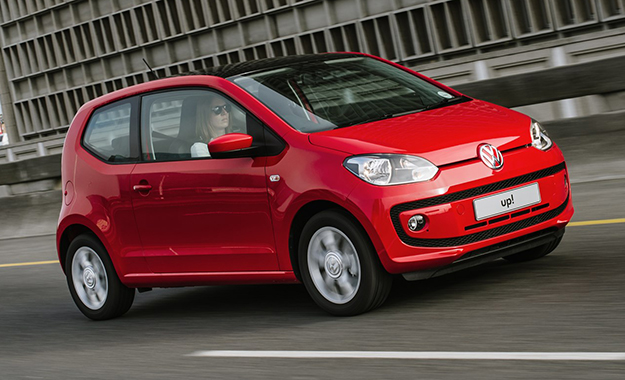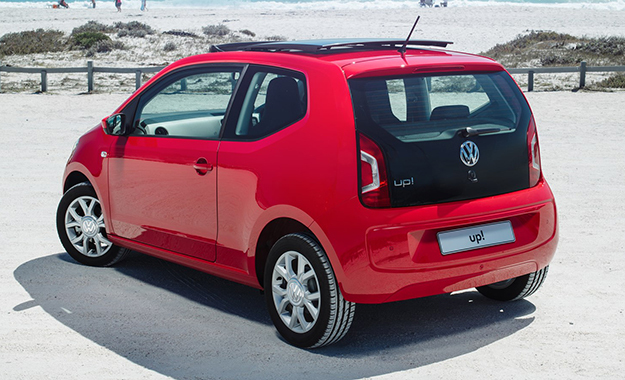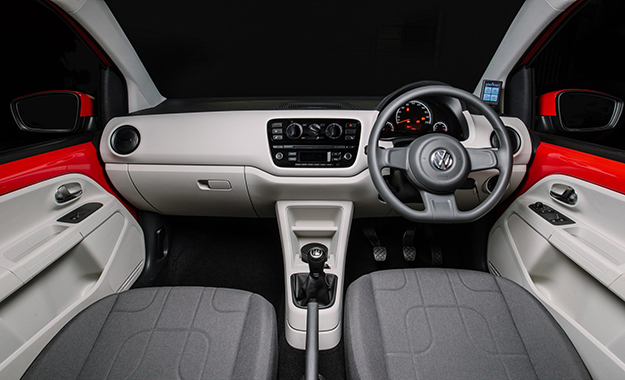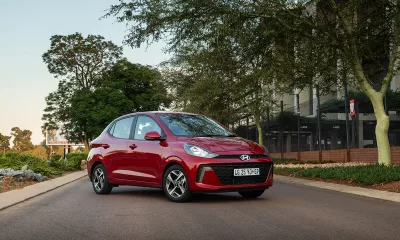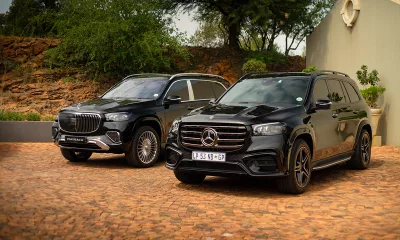Volkswagen SA’s already burgeoning line-up has a new addition in the shape of the firm’s long-awaited Up! supermini. Occupying the slot below the immensely popular Vivo model range, the Up! promises to deliver a characterful motoring experience in a compact, value-for-money package that Volkswagen claims will dominate the A-segment. Given that it’s an ecosystem occupied by the likes of the very competent Hyundai i10/Kia Picanto and Chevrolet Spark, it’ll be no mean feat – so does the Up! have the goods to make a big impact among the small car market?
Styling & packaging
Styling-wise the Up! manages to tread a fine line between the solid Germanic lines by which the company’s wares are easily identified and the cute/boutique touches that will likely appeal to VW’s intended target market in the 20-30-years-old bracket.
Among the highlights are a lower grille section that’s intended to emulate a friendly smile and, perhaps the most striking of all, the rear hatch with its blacked-out glass panel. The latter element has been seen in other cars of the Up!’s ilk (think Citroën C1) but, unlike its contemporaries, it doesn’t comprise a flimsy feeling section of glazing but is fitted atop a solid boot panel making it feel considerably more robust. In its range-topping Move Up! guise, the whole shooting match rolls on a set of fetching looking 15-inch alloy wheels.
Measuring 3 540 mm long, 1 489 mm wide and 1 489 mm high, thanks in no small part to its short overhangs, the Up! is positively miniscule – even within its segment.
Even so, the interior feels surprisingly airy owing to deep glazing that grants occupants an excellent view of their surroundings. Going for the cream facia trim panels furthers the impression of spaciousness, although these particular items do look vulnerable to marking. Sitting two up front isn’t the elbow-rubbing experience you’d expect of such a small car, while the combination of steering rake and height adjustment for the elevated front pews ensured makes finding a comfy driving poise a doddle.
As expected, the rear accommodation of mainly the reserve of kids and those happy to squeeze in there for short hops but at least the aforementioned airiness ensures that it doesn’t feel too claustrophobic back there. The Up!’s boot, with a claimed capacity of 251 dm3, managed to accommodate two medium-sized hard cases with a bit of stacking room to spare and features a nifty two-tier load floor beneath which lies a full-sized spare wheel. Drop the rear seatbacks and there’s a claimed 951 dm3 of utility space to exploit and loads of up to 2 metres in length can be accommodated, albeit minus a front passenger.
Hard plastics are the order of the day here but their fit and material quality are as good as you’d expect from something from the VW stable – understandable when you take into consideration that the Up! is produced at the same Slovakian plant that turns out the Touareg.
Drive & Performance
On paper the 55 kW and 95 N.m developed by the Up!’s 1,0-litre three-pot looks somewhat modest but, allied with a sub-one-tonne kerb weight, it provided enough go to ensure that progress wasn’t sluggish. Power delivery is more on the progressive than punchy side, so overtaking or traffic-gap-grabbing is a foot flat and forward planning affair, but thankfully the snappy, short-throw gearshift and easily modulated clutch help matters no end.
Highway driving not only highlighted the Up!’s surprisingly planted and solid-feeling nature, but also impressive NVH levels owing to a tall fifth gear that ensures that the engine isn’t screaming away at the national limit.
Dynamically you’re aware that you’re piloting a car with a fairly high centre of gravity and that, along with the elevated seating position, occasionally gives the impression that snap maneuvers at speed aren’t the Up!’s forte, but that’s really not its milleu – those compact dimensions and an electromechanical steering set-up that’s surprisingly precise and full of feel makes the Up! a consummate urban runabout.
Value for money
A glance at the Up!’s pricing, especially the range-topper, sees it placed just R3 000 or so adrift of the entry-level Polo Vivo 1,4 Conceptline – a position that some may see as a perilously narrow gap dividing it from an appreciably larger, albeit far more modestly equipped car.
Even the gap between the entry-level Take Up! model and its higher-placed sibling is a narrow one. The lower-specced model’s standard equipment includes a respectable array of safety features (ABS with Brake Assist; dual front and thorax airbags, rear Isofix anchorage points) air conditioning and 14-inch steel wheels.
Plumping another R7 000 for the Move Up! adds colour-coded mirrors and door handles, driver and passenger seat height adjustment, electric windows up front, electrically adjustable mirrors, remote central locking and a radio/CD/MP3 audio system, among others – so that’s where the smart money will likely go. VW claims a 4,7 L/100 km fuel consumption, but on our mixed-use launch route we managed a still-respectable 5,7.
Verdict
VW has big hopes for this model, aiming for sales of around 250 units per month, and although this is an ambitious target the product looks as though it has the means to give it a good go.
It has enough character there to appeal to first-time buyers and young, trendy urbanites for whom other boutique city hatches as the Fiat 500 and Opel Adam are a stretch too far, while the build quality and driving experience are essentially distilled VW fare.
